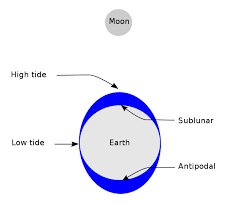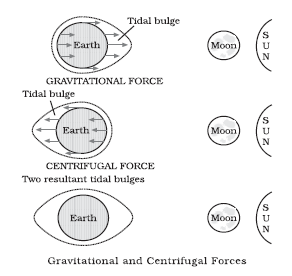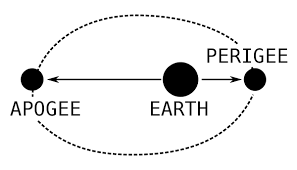1. Multiple choice questions.
(i) Upward and downward movement of ocean water is known as the:
(a) tide
(b) current
(c) wave
(d) none of the above
Answer: (a) tide
Explanation: The upward and downward movement of ocean water is known as tide. Tides are the periodic rise and fall of sea levels caused by the gravitational pull of the moon and the sun on Earth’s waters. This gravitational force creates bulges of water that move across the Earth’s oceans as the planet rotates, resulting in the cyclic phenomenon of tides. Tides play a crucial role in coastal ecosystems, navigation, and various geological processes.

(ii) Spring tides are caused:
(a) As a result of the moon and the sun pulling the earth gravitationally in the same direction.
(b) As a result of the moon and the sun pulling the earth gravitationally in the opposite direction.
(c) Indentation in the coastline.
(d) None of the above.
Answer: (a) As a result of the moon and the sun pulling the earth gravitationally in the same direction.

Explanation: Spring tides are caused by the combined gravitational forces of the moon and the sun acting in the same direction, resulting in higher high tides and lower low tides. This occurs during the full moon and new moon phases when the sun, moon, and Earth are aligned. The gravitational pull of both celestial bodies intensifies, causing the ocean’s water levels to rise more than usual. Spring tides have a greater tidal range and are not related to the season “spring.”
(iii) The distance between the earth and the moon is minimum when the moon is in:
(a) Aphelion
(b) Perigee
(c) Perihelion
(d) Apogee
Answer: (b) Perigee
Explanation: The distance between the Earth and the moon is minimum when the moon is at its closest point to Earth, known as perigee.

During perigee, the moon’s orbit brings it closest to our planet, resulting in a shorter distance between the two celestial bodies. This proximity can lead to slightly larger and brighter full moons, often referred to as “supermoons.”
(iv) The earth reaches its perihelion in:
(a) October
(b) September
(c) July
(d) January
Answer: (d) January
Explanation: The Earth reaches its closest point to the sun, known as perihelion, in the month of January. During this time, Earth is approximately 147 million kilometers (91.4 million miles) away from the sun, compared to its farthest point (aphelion) in July when it is about 152 million kilometers (94.5 million miles) away. The variation in Earth’s distance from the sun contributes to the changing seasons on our planet.

2. Answer the following questions in about 30 words.
(i) What are waves?
Ans: Waves are oscillations of water’s surface caused by the wind’s frictional drag. They transmit energy across oceans and other bodies of water, resulting in the rising and falling of water levels.
(ii) Where do waves in the ocean get their energy from?
Ans: Waves in the ocean derive their energy mainly from the wind’s kinetic energy as it blows across the water’s surface. The stronger the wind, the more energy is transferred to the waves.
(iii) What are tides?
Ans: Tides are periodic and predictable changes in sea level caused by the gravitational interactions between Earth, the moon, and the sun. They result in the rise and fall of water levels along coastlines.
(iv) How are tides caused?
Ans: Tides are primarily caused by the gravitational pull of the moon and the sun on Earth’s waters. The moon’s closer proximity leads to stronger gravitational effects, resulting in higher high tides and lower low tides.
(v) How are tides related to navigation?
Ans: Tides significantly influence navigation by affecting water depths. High tides provide ample clearance for ships to navigate through shallow areas, while low tides can make navigation challenging. Mariners use tide tables to plan safe passages and avoid grounding during low-tide conditions.
3. Answer the following questions in about 150 words.
(i) How do currents affect the temperature? How does it affect the temperature of coastal areas in N. W. Europe?
Ans: Ocean currents play a significant role in regulating temperature by redistributing heat globally. Warm currents raise temperatures in adjacent coastal regions, while cold currents have a cooling effect. In the case of N. W. Europe, the North Atlantic Drift, an extension of the Gulf Stream, carries warm water northward, significantly influencing the climate. Coastal areas like the United Kingdom experience milder winters due to this warm-water influx. However, if this current weakens, as projected by climate models due to ice melt, it could lead to altered temperature patterns and climate changes in the region.
(ii) What are the causes of currents?
Ans: Ocean currents result from a complex interplay of wind patterns, temperature gradients, Earth’s rotation, and the Coriolis effect. Wind exerts a major influence, pushing surface waters and generating currents. Temperature differences between equatorial and polar regions drive thermal gradients that initiate circulation. Earth’s rotation and the Coriolis effect cause deflection of moving water, resulting in the creation of gyres and currents. Additionally, variations in water density due to salinity differences contribute to vertical and horizontal movements, shaping the intricate system of oceanic currents that help regulate Earth’s climate and transport nutrients.
